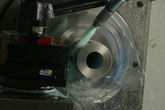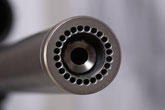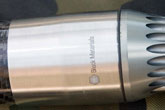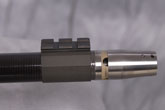BLACK MATERIALS GROUP
Industrial Design

|
Black Materials Group, LLC
Industrial Design |
|
Explanation of Industrial Design Specification Process
Black Materials uses the Industrial Design Specification Process to systematize the detailed, intricate process of conceiving and manufacturing a new product.
The Industrial Design Specification Process is the systematic process of conceiving, designing, modeling, prototyping, testing, manufacturing, marketing and ultimately supporting the new product design. Any individual or company that seeks to bring a product to market must complete the tasks listed below. However, the ability to complete these tasks varies greatly between inventors. A new inventor usually will begin at the concept stage; able to verbally describe the new invention and possibly make a sketch or crude model, but may not have the skills or tooling to produce a prototype. A more experienced tradesman or engineer who conceives of a new product may have the skills to produce an initial concept and detailed design, but not have the tooling or marketing knowledge to proceed to the actual manufacturing and sale of the new product. Additional steps in the product design specification process may include market analysis, OEM and raw materials specifications/selection, computer-modeled failure analysis, physical failure analysis, custom fixtures for failure testing, patent counseling, small or large production run options, physical prototyping, product operator training, and product support plans. The macro-level path for design implementation is: Concept Creation Market Analysis Specifications/CAD Modeling Prototype Test Short Production Run Flash Marketing Plan Secure/Promote/Negotiate Intellectual Property The goal is to repeat this process as often and as quickly as possible. Black Materials Group, LLC seeks to help all inventors bring their ideas to market as quickly and systematically as possible. Everyone in the organization has a passion for invention and construction. We relish the chance to bring a new product idea to life and offer services for all levels of inventors. Regardless of the technical experience of the inventor, the following design tasks will have to be considered. Additional steps specific to a product, such as governmental regulatory compliance, etc. The Industrial Design Specification Process: Concept Exploration to First Hardcopy Sketch Macro Market Analysis Computer Model Materials Selection/Engineering Design Intellectual Property Protection Plan/Patent Filing(s) 3-D Plastic or Metal Physical Prototype Production Product Testing/Engineering Analysis Production Run Planning/Tooling Requirements/CNC Programming Initial Automated Production/Assembly Trial Full Production Operations Product Support Plan Flash Marketing Plan Packaging/Shipping Issues Liability Insurance Application Intellectual Assets Licensing Counseling Sell and Commence Full Production of New Product Example 1 - Design Project for a New Tool: A typical design specification for an amateur inventor might involve a professional mechanic that has a new idea for a special tool. He knows what the tool must do and its basic function, but has no idea how to proceed from there. He also knows he needs a prototype to test in the field and some help with materials selection. The following initial design steps need completing: Concept Exploration to First Hardcopy Sketch Macro Market Analysis Computer Model Materials Selection/Engineering Design Intellectual Property Protection Plan/Patent Filing(s) 3-D Plastic or Metal Physical Prototype Production Product Testing/Engineering Analysis First, we work with the inventor to do a basic market analysis for this tool. Are there similar tools on the market? The advertisements and other public-domain specifications for any competing products would be collected. We would address the question of financial viability of the cost of tooling and production vs. the expected market and profits. If the product is determined viable, we move to the design/prototype tasks. After the computer modeling and 3-D prototyping, the inventor decides if he wants to move to the patent stage and/or engage in various intellectual property protections such as trademarks and copyrights. The new inventor in this example receives the following key deliverables from Black Materials Group: CD ROM copy of your design concept in SolidEdge format 2-D Hardcopy Blueprint of design concept with dimensions Preliminary raw materials selection and rationale Physical Prototype of the Design Concept Documented Test Data and Results Conclusion: Depending of the complexity of the product design, this design analysis would cost between $3,000.00-$5,000.00. Production plans would follow market response and initial sales. Descriptions of Design Phases: Concept Exploration to First Hardcopy Sketch This step involves a basic exploration of the technical requirements of the product design, potential market, cost of entering the market, survey of competition, etc. An inventor would also provide some hand-drawn concept sketches and other basic materials specifications. An assessment is made of the complexity of the design, a key in pricing the production. The inventor is presented with a list of check-off items to cover in this stage. Macro Market Analysis Here the inventor must look deeper into the manufacturing costs and potential payback schedule. Decisions depend greatly on the decision to do in-house production or use contract manufacturers. Marketing surveys may be conducted at tradeshows or other industry events to help for predictions for future sales. This data gathering culminates in a cost-benefit analysis. Often, an inventor may not decide to continue, if the idea is not economically feasible. If the product is feasible for further development, we would progress to the modeling tasks. Computer Modeling - Computer-Aided-Design (CAD) The most efficient method for product design is computer modeling. It allows a seamless design cycle, progressing from concept, to management the CAD files themselves, to three dimensional prototyping, failure testing, and finally conversion to CNC machine code to drive the automated metal production machinery. These systemized principles are referred to as product lifecycle management (PLM). SolidEdge design software, the 3-D modeling software Black Materials uses to model [the] products, is also a leader in the PLM software sector. Black Materials takes advantage of these tools to move from one design task to the next. Materials Selection/Engineering Design Once the application is understood, the raw materials must be selected that possess the material properties to take the stress of the tool or product use. Intellectual Property Protection Plan/Patent Filing(s) Determining when and if to attempt to file a patent is a difficult decision. The costs for lawyer fees, engineering analysis, and filing fees can exceed $10,000.00. Key issues include the likelihood of having the patent granted, the type of patent, technical complexity, ease of copying, and the ability to define proprietary manufacturing methods. 3-D Plastic or Metal Physical Prototype Production From a 3-D CAD model, a plastic or high-density foam prototype can be manufactured with these new design machines. Black Materials can simply email to CAD part file to one of the many subcontractors and have a plastic part produced. This part can be test fit with others and used as an investment casting mold to produce a finished metal part. The cost for the plastic part is approximately $1000.00. Product Testing/Engineering Analysis Any new product must be tested for functionality and liability exposure, especially those products that come in contact with people. Finite Element Analysis software can be used to simulate the failure of the CAD model. Then a physical product failure test is done to confirm the computer models. There are the direct costs of destroying prototypes, along with possible substantial test tooling and/or failure test fixtures that may have to be built. Production Run Planning/Tooling Requirements/CNC Programming This may include all CNC or manual tooling required, physical plan requirements, personnel, personnel protection equipment and protection plan, governmental regulations, machine and tooling maintenance, and raw material storage plan. Initial Automated Production/Assembly Trial Test the production to assess quality and functionality. Full Production Operations Commence production and start shipping/invoicing products. Product Support Plan This may include parts inventory, telephone or internet support, parts ordering, and managing a crew of service workpeople. Marketing Plan Our experience producing parts for the industrial market gives us a unique perspective into what appeals to industrial customers. Packaging/Shipping Issues Shipping providers and special packaging needs definition and cost estimates. Liability Insurance Application A key final consideration is liability insurance coverage. Many of these issues will have to be reviewed to determine potential product liability. Often, insurance underwriters will require independent engineering analysis for product testing data. Related issues include product warning labeling, engraving and marking product identification numbers, and repair parts organization and support systems. Intellectual Assets Licensing This is the ultimate goal of the product development effort. It frees up the inventor to work on new inventions and provides a residual income stream. With the proper patents or trademarks in hand, a deal for large production runs will be negotiated.
UGS PLM SolidEdge Design Software (3-D Modeling)
Black Materials uses UGS PLM SolidEdge design software for 3-D modeling.
AutoCAD LT97 (2-D Modeling)
Black Materials uses AutoCAD LT97 for 2-D modeling.
|
Black Materials Group, LLC
Industrial Design
2200 Walnut Ave, Austin, Texas 78722
Office: (512) 481-0304 Mobile: (512) 789-7417
Fax: (512) 481-0921 Email: sales@blackmaterials.com
Industrial Design
2200 Walnut Ave, Austin, Texas 78722
Office: (512) 481-0304 Mobile: (512) 789-7417
Fax: (512) 481-0921 Email: sales@blackmaterials.com



